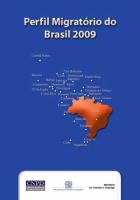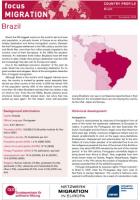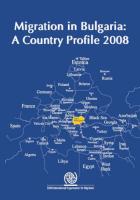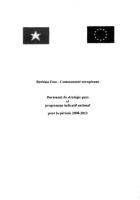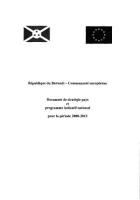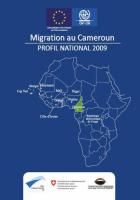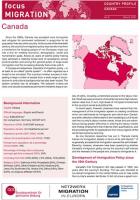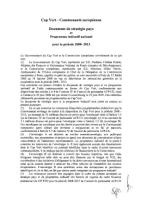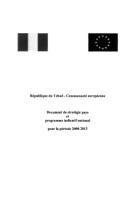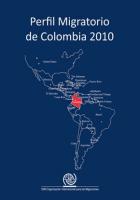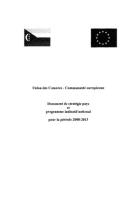
Please note that MPs/EMPs collected in this repository differ significantly in terms of format, content and objectives. Extended MPs emphasize the importance of national ownership and sustainability of the MP exercise by engaging in consultations with a broad range of stakeholders including the civil society.
Refine your search
Históricamente, Bolivia es un país con saldo migratorio negativo. Factores estructurales inciden en los bajos niveles de desarrollo humano de la población, explicando este carácter emigratorio del país. En la actualidad, más de 700 mil bolivianos residen en el exterior, representando un 6,8% de la población total. Argentina continúa siendo el...
The Migration Profiles in South-Eastern Europe were created partly in reaction to the EU Council Conclusions of June 2007 on Extending and Enhancing the Global Approach to Migration, based on the Commission Communications of May 2007 on applying the Global Approach to migration to the Eastern and South-Eastern regions neighbouring the European...
The Bosnia and Herzegovina Migration Profile (hereinafter: BiH Migration Profile) resulted from the need to establish a mechanism for gathering statistical data on migration and international protection, a system for processing migration statistics, and a system for timely and adequate reporting on migration flows in BiH. The aim of this document...
Botswana is a model for the use of natural resources for development. It has evolved from one of the ten least-developed countries at independence in 1966 to a middle-income country, characterised by sustained economic growth, anchored in good governance, peace, political stability and sound macroeconomic management. Fundamental human rights and...
This Migration Profile of Brazil belongs to the series of the first four South American profiles produced by IOM´s Research Unit, in coordination with IOM offices in the region. The preparation of the Profile was possible thanks to the close collaboration with Brazilian government agencies involved with migration management. The Migration Profile...
Brazil, the fifth biggest country in the world in terms of area and population, is primarily known in Europe as an attractive holiday destination and former immigration country. Between the first Portuguese settlement in the 16th century and the Second World War, more than four million people migrated to the country, most of them Europeans. In the...
“Migration in Bulgaria: A Country Profile 2008” is part of a series of migration profiles produced by IOM Budapest within the “Black Sea Consultative Process on Migration Management” project, funded from IOM’s 1035 Facility. Migration from Bulgaria was mainly ethnically driven in the aftermath of the collapse of the socialist regime and concerned...
A landlocked Sahelian country, Burkina Faso counts among the world's poorest. It has a population of 13.7 million (2006 figures) and a surface area of 274 000 km². With few natural resources and a deteriorating natural environment, it is also subject to the imponderables of a Sahelian climate; rainfall is often inadequate or unevenly distributed...
During the lifetime of the ninth European Development Fund (EDF), covering the years from 2003 to 2007, the European Community was able to support Burundi during a transitional period of crucial importance to the country's future. This transition took place first and foremost on a political level. Following the Arusha Accords, it was possible to...
Au Cameroun, les flux migratoires actuels se traduisent, d'une part, par un mouvement général des campagnes vers les villes et, d'autre part, par une tendance à l'émigration vers l'Europe, en particulier vers la France. Grâce à son potentiel socio-économique et à sa relative stabilité politique, le pays s'est avéré une zone de destination des flux...
In view of the fact that the Poverty Reduction Strategy Paper (PRSP) requires Cameroon to combat poverty and in accordance with the recommendations of the European Consensus on Development, Cameroon has opted to channel the indicative amount of EUR 239 million allocated under the 10th EDF A-envelope to two priority areas: Governance, with a...
Since the 1980s, Canada has accepted more immigrants and refugees for permanent settlement in proportion to its population than any other country. In the course of the twentieth century, the country’s immigration policy was transformed from a mechanism for keeping people of non-European origin out into a tool for meeting economic, demographic...
Although Cape Verde has a great emigration tradition, immigration to Cape Verde has increased in recent decades. The latest data indicate that the immigrant population has risen by around 20 per cent from 8,931 in 1991 to reach 12,305 in 2010. The majority of immigrants in Cape Verde come from the Portuguese-speaking African Countries and from...
Cape Verde is seen as a model of democracy in Africa. The country has been a multi-party democracy since 1990, governments of different stripes have succeeded each other seamlessly, and political rivalry remains peaceful. The fundamental freedoms are recognised and guaranteed by law and observed in practice. The separation of powers, and in...
The MTM Interactive Map on Migration (i-Map) is an online interactive platform in support of the Mediterranean Migration Dialogue. The country profiles provide factual, non-analytical information and a series of graphs illustrating the main datasets relevant to Migration and Development in the country. The profiles give access to a plethora of...
Ranked 171st out of 177 on the Human Development Index, the Central African Republic managed during 2005 to leave behind a long period of political and military tensions by holding internationally recognised elections restoring constitutional order. There are many challenges surrounding security, socio-economic indicators, good governance, human...
Chad is a landlocked country at the heart of central Africa and is as vast as France, Germany and Poland taken together. The northern half of the country is in the Sahara region and is home to only 1% of the 9 million Chadians. Three-quarters of the population live in rural areas. In terms of human development indicators, the 2006 UNDP report ranks...
The Colombia Migration Profile illustrates the current status of migration in this country. Colombia is a multicultural country with a projected population for 2010 of 45,508,208 inhabitants, of which 49.37 per cent are male and 50.63 per cent are female. In Colombia, migration flows from the dynamic of a society that transforms itself according to...
Situated at the northern end of the Mozambique Channel, the archipelago of the Comoros consists of four islands, three of which, Grande Comore (Ngazidja), Anjouan (Ndzwani) and Mohéli (Mwali), covering an area of 1 861 km2, form the Union of the Comoros, while the fourth, Mayotte (Mahoré), remained French when the Comoros gained independence. The...
In view of the requirement to combat poverty set out in the Growth and Poverty Reduction Strategy Paper and in the light of the Government's programme, both of which are included as objectives in the plan of priority actions presented in June 2007, and in line with the recommendations of the European Consensus on Development, the Democratic...




